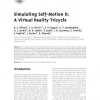Free Online Productivity Tools
i2Speak
i2Symbol
i2OCR
iTex2Img
iWeb2Print
iWeb2Shot
i2Type
iPdf2Split
iPdf2Merge
i2Bopomofo
i2Arabic
i2Style
i2Image
i2PDF
iLatex2Rtf
Sci2ools
VR
2002
IEEE
2002
IEEE
Simulating Self-Motion II: A Virtual Reality Tricycle
: When simulating self-motion, virtual reality designers ignore non-visual cues at their peril. But providing non-visual cues presents significant challenges. One approach is to accompany visual displays with corresponding real physical motion to stimulate the non-visual, motion-detecting sensory systems in a natural way. However, allowing real movement requires real space. Technologies such as Head Mounted Displays (HMDs) and CAVEY s can be used to provide large immersive visual displays within small physical spaces. It is difficult, however, to provide virtual environments that are as large physically as they are visually. A fundamental problem is that tracking technologies that work well in a small, enclosed environment do not function well over longer distances. Here we describe Trike
| Added | 23 Dec 2010 |
| Updated | 23 Dec 2010 |
| Type | Journal |
| Year | 2002 |
| Where | VR |
| Authors | Robert S. Allison, Laurence R. Harris, A. R. Hogue, Urszula Jasiobedzka, H. L. Jenkin, Michael Jenkin, P. M. Jaekl, J. R. Laurence, Greg Pentile, Fara Redlick, James E. Zacher, Daniel C. Zikovitz |
Comments (0)

